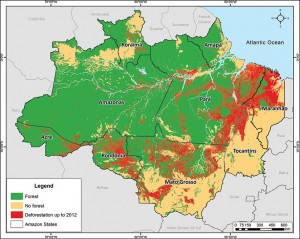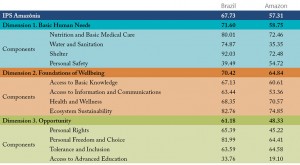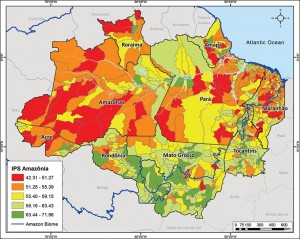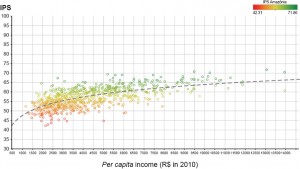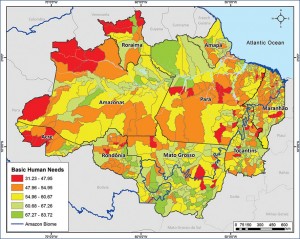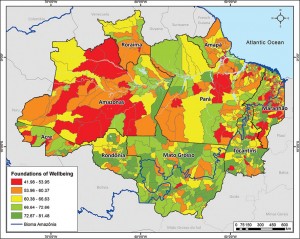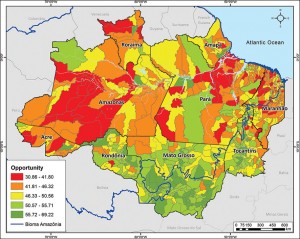THE IMPORTANCE OF MEASURING SOCIAL PROGRESS IN THE AMAZON
The Brazilian Amazon is superlative in natural resources, harboring one-third of the world’s tropical forests and the planet’s largest hydrographic basin. Beneath this region lies one of Earth’s richest mineral deposits. Moreover, the Amazon forest retains vast amounts of carbon and plays a strategic role in the regulation of regional and global climate.
More than 24 million people also live in the Amazon. This population has experienced social conditions worse than the other regions of Brazil. These conditions are associated with a development pattern largely driven by deforestation, extensive use of natural resources, and social conflicts. The region’s continental size and lack of infrastructure pose additional challenges to advancing social and economic progress.
The region has an almost real-time deforestation monitoring system through satellite images, which serve as a reference for the tropical world. However, measuring its social situation remains a great challenge. Indeed, the frequency of data updates is low and there are limitations in the geographic scope of some indicators. Moreover, until recently, the Amazon’s social performance was assessed only by indexes which are themselves highly influenced by economic indicators. With the creation of the Social Progress Index (SPI) methodology in 2013, it became possible to evaluate the region’s social progress by considering only the social and environmental indicators which are really key for people’s quality of life.
The Social Progress Index in the Brazilian Amazon – IPS Amazônia (Índice de Progresso Social na Amazônia Brasileira – IPS Amazônia) 2014 full report[1], a product of collaboration fostered by the network #Progresso Social Brasil, prepared by Imazon in partnership with the Social Progress Imperative, is available on the websites
www.imazon.org.br and www.progressosocial.org.br. The report represents the most detailed diagnosis ever attempted of the social and environmental progress of the Amazon’s 772 municipalities[2] and nine States. The data and results broken down to the municipality scale are available on the website www.ipsamazonia.org.br.
__________________________
[1] An English-language version of the full report will be available online later this year.
[2] Because of data gaps for one municipality, Mojuí dos Campos (Pará), only 772 of the 773 municipalities in the Brazilian Amazon were included in this study.
WHAT IS THE SOCIAL PROGRESS INDEX?
The SPI is an index that measures, in a holistic and robust way, the social and environmental performance of nations and territories, regardless of their economic development (Social Progress Imperative, 2014). It was created in 2013 by the Social Progress Imperative, in a process supported by several world-class scholars and specialists in public policies. The SPI was devised with the understanding that development measurements based only on economic variables are insufficient, since economic growth without social progress leads to exclusion, social dissatisfaction, social conflicts, and environmental degradation (Social Progress Imperative, 2014). The global SPI 2014 includes 54 social and environmental indicators.
The index incorporates four key design principles:
Principles of SPI
- Exclusively social and environmental indicators: it aims to measure social progress directly, rather than through economic proxies.
- Outcomes not inputs: it aims to measure outcomes that matter to the lives of real people, not spending or effort.
- Actionability: the index intends to be a practical tool, able to help leaders and practitioners in government, business and civil society to implement policies and programs that will drive faster social progress.
- Relevance: it aims to create a framework for the holistic measurement of social progress that encompasses the health of societies at all levels of economic development
“Social progress” is defined by the Social Progress Imperative as the capacity of a society to meet the basic human needs of its citizens, establish the building blocks that allow citizens and communities to enhance and sustain the quality of their lives, and create the conditions for all individuals to reach their full potential (Social Progress Imperative, 2014). Three questions, essential for assessing the social progress of a given location, stem from this definition:
- Does a country provide for its people’s most essential needs?
- Are the building blocks in place for individuals and communities to enhance and sustain wellbeing?
- Is there opportunity for all individuals to reach their full potential?
These three questions define the three dimensions of social progress: 1) Basic Human Needs; 2) Foundations of Wellbeing; and 3) Opportunity. Each of these dimensions is made up of four components, and each component is composed of three to six indicators.
Structure of the Social Progress Index at the component level
SOCIAL PROGRESS INDEX IN THE BRAZILIAN AMAZON
The SPI was originally proposed for the global scale and to measure social progress at the level of countries. However, since its launch in 2013, several national and sub-national initiatives have appeared. The IPS Amazônia seeks to answer the same questions as the global SPI and has the same statistical method. Nevertheless, some of the indicators used are different to better represent the reality of the region. For instance, indicators such as malaria incidence and deforestation rate are paramount for the Amazon, even though they are not so relevant for other areas of the globe. In order to calculate the IPS Amazônia, 43 indicators, recent and from reliable sources, have been used[3]. The index ranges from 0 (worst) to 100 (best).
The Brazilian Amazon
Legal Amazon is a socio-geographic division of Brazil that covers 59% of the territory (5 million square kilometers) and comprises nine states (Acre – AC, Amazonas – AM, Amapá – AP, Maranhão – MA, Mato Grosso – MT, Pará – PA, Rondônia – RO, Roraima – RR and Tocantins – TO) and 773 municipalities. This region is home to approximately 24 million inhabitants (13% of the national population). Although most (72%) of the population is concentrated in urban areas, the region safeguards one of the world’s largest ethnic and cultural diversities: over 170 indigenous peoples with a population estimated at approximately 400,000 people (IBGE, 2010). In spite of its small participation in the national economy, with only 8% of Brazil’s gross domestic product (GDP), the region’s wealth in natural resources and environmental services is priceless.
__________________________
[3] For more information about the methods and the indicators, please read the full report available at www.imazon.org.br.
MAIN RESULTS OF IPS AMAZÔNIA – OVERALL PERFORMANCE
The Amazon has an IPS score[4] (57.31) under the national average (67.73). In fact, the region yields results below the Brazilian average for all three dimensions and almost all components of the SPI. Although we use, in the IPS Amazônia 2014 report, the average of Brazilian municipalities to assess and compare the performance of the Amazon region, it is important to point out that social progress as measured by the global SPI for Brazil is not favorable either. According to the international rankings presented by the Social Progress Imperative in 2014, the country ranks just 46th of 132 countries, and those in the best positions (New Zealand, Switzerland, and Iceland) boast a score of over 88.
The best IPS result for the Amazon is in dimension 2 (Foundations of Wellbeing) with an average index score of 64.84, whereas dimension 1 (Basic Human Needs) shows intermediate results (58.75) and dimension 3 (Opportunity) has the worst performance in the region with a score of only 48.33. This last dimension also displays the greatest disparity between the region and the rest of the country (21%), making it clear that there is a lack of opportunity for the population of the Amazon.
Results of IPS Amazônia 2014
__________________________
[4] Unless directly referenced, all scores in this report are from the IPS Amazônia methodology. Any scores from the global Social Progress Index 2014 are noted as such.
MAIN RESULTS OS IPS AMAZÔNIA – PERFORMANCE OF MUNICIPALITIES
The Amazon municipalities were grouped in five levels of social progress, according to their score. The first group includes the 87 municipalities with the best results (dark green in the map), where the average IPS Amazônia score is 65.79. These municipalities cover 390,000 square kilometers (approximately 8% of the territory of the region) and have a population of 9.4 million inhabitants (39% of the Amazon population). This group accounts for more than half (53%) of the region’s GDP. In this group all capitals are included, except Porto Velho (Rondônia). Although they boast the best results of municipalities in the Amazon, most of these municipalities still perform below the Brazilian average.
IPS Amazônia at municipality level
The second group has 200 municipalities and presents an average score of 61.13 (light green in the map). These municipalities cover an area of 1 million square kilometers (21% of the territory), house a population of 4.8 million inhabitants (20%), and their GDP contributes 23% of the regional GDP. In this group, we find Rondônia’s capital, Porto Velho, and also the municipality with the Amazon’s highest per capita income: Campos de Júlio (MT).
The third group has 194 municipalities which show an average score of 57.21 (yellow in the map). This group includes municipalities with noted differences in the level of economic development, measured by the per capita income ranging from USD 1,100 per year in Barreirinha (AM) to USD 5,800 in Ipiranga do Norte (MT). It shows that good economic performance does not necessarily ensure social progress. Other municipalities in this group are Marabá (PA), Ariquemes (RO), Paragominas (PA), Alta Floresta (MT), and Oiapoque (AP).
The fourth group (orange in the map) gathers the highest number of municipalities (204) and has an average score of only 53.59. These municipalities cover 29% of the territory, house 20% of the total population and account for only 9% of the Amazon’s GDP. In the map, it is observed that a great part of the municipalities of this group is concentrated on the same zone of latitude, moving from East (in Maranhão), across Pará to the West in Amazonas and Acre. The municipalities of Coari (AM), Novo Progresso (PA), Itaituba (PA), and Raposa (MA) are some of the municipalities in this tier of social progress.
Finally, 87 municipalities make up the fifth group (red in the map), which shows the lowest levels of social progress in the Amazon: the average score is just 49.00. One million seven hundred thousand inhabitants (7% of the region) live in these municipalities which account for only 3% of the regional GDP. Thirty-eight percent of these municipalities are in Maranhão and 26% in Pará. The municipalities with worst results in the region are Anapu (PA), Alto Alegre (RR), Brejo de Areai (MA) and Jordão (AC).
Weaknesses and strengths of the Amazon municipalities (scorecards).
Social progress, as measured by IPS Amazônia, its three dimensions, 12 components and 43 indicators, can be individually evaluated for all the municipalities of the Amazon region through scorecards available on the website www.ipsamazonia.org.br. All the municipal results and the position of each municipality in the regional ranking are shown, and the results are given a green (good result), yellow (neutral) or red (weak) card, in relation to other municipalities at the same level of income. A sample of the scorecard system is below.
MAIN RESULTS OF IPS AMAZÔNIA – SOCIAL PROGRESS AND ECONOMIC DEVELOPMENT
One of the objectives of using the SPI methodology is to better understand the relationship between social progress and economic development (Social Progress Imperative, 2014). Although the IPS Amazônia has a high, positive correlation with the per capita income of the Amazon municipalities (0.62), the data distribution shows that economic performance alone is not enough to fully explain social progress outcomes, since the relation between social progress scores and per capita income is not linear. There is great variation of social progress in the municipalities with the same level of per capita income.
Some municipalities with very low per capita income show relatively high scores when compared to other municipalities with the same level of income. For instance, Magalhães Barata (PA), Porto Rico do Maranhão (MA), and Parintins (AM) have scores in the highest level even though they show very low per capita income when compared to the capitals. On the other hand, there are several municipalities with income above the regional average which show scores in the lowest levels, among them: Campo Novo (RO), Bom Jesus do Araguaia (MT), Cumaru do Norte (PA), and Pedra Branca do Amaparí (AP). That is, social progress differs from economic development, though they are correlated.
Ratio between IPS Amazônia scores and per capita income in the Amazon municipalities
MAIN RESULTS OF IPS AMAZÔNIA – THE DIMENSIONS OF IPS AMAZÔNIA
Dimension 1 (Basic Human Needs)
This dimension of IPS Amazônia shows whether the population has its most basic needs ensured, by means of four components: Nutrition and Basic Medical Care, Water and Sanitation, Shelter, and Personal Safety. This dimension is the one which shows the second worst result in the Amazon (58.75). All the components and indicators assessed are concerning, especially the component Water and Sanitation, with the second worst result among all (35.35). The disparity between the Amazon and the rest of Brazil in this dimension is 18%.
Dimension 1. Basic Human Needs in the Amazon municipalities
Dimension 2 (Foundations of Wellbeing)
This dimension of IPS Amazônia shows whether the Amazon municipalities have the necessary structure to ensure social wellbeing, defined by four essential components: Access to Basic Knowledge, Access to Information and Communications, Health and Wellness, and Ecosystem Sustainability. This is the highest performing dimension for the Amazon, scoring 64.84. However, the index is still 8% below the Brazilian average.
Dimension 2. Foundations of Wellbeing in the Amazon municipalities
Dimension 3 (Opportunity)
This dimension estimates the level of opportunity existing in the Amazon municipalities by means of four components: Personal Rights, Personal Freedom and Choice, Tolerance and Inclusion, and Access to Advanced Education. This is the lowest performing dimension in the Amazon, showing an average index score of only 48.33, whereas in the rest of Brazil it is 61.18. The component Access to Advanced Education is the worst of all the IPS Amazônia components, with a result of 19.10.
Dimension 3. Opportunity in the Amazon municipalities
CONCLUSION
The Amazon region is recognized worldwide for its superlative natural resources and for the environmental services it provides to Brazil and to the rest of the planet. This wealth has been used in a predatory manner with high rates of deforestation and social conflicts. At the same time, serious social problems persist in the region and opportunities for social progress for the majority of the population are missing. Social progress, as it is measured by IPS Amazônia, reveals that the region is below the Brazilian average, which is incompatible with the region’s environmental importance. The next general elections (president, governors and state and federal legislation), in October 2014, offer an outstanding moment to discuss social and environmental issues of the region and propose solutions to improve the social progress of over 24 million inhabitants of the Amazon. The full report Índice de Progresso Social na Amazônia Brasileira – IPS Amazônia 2014 (“Social Progress Index in the Brazilian Amazon – IPS Amazônia 2014”) may be used as a compass to guide the management and the public policies in the region.


